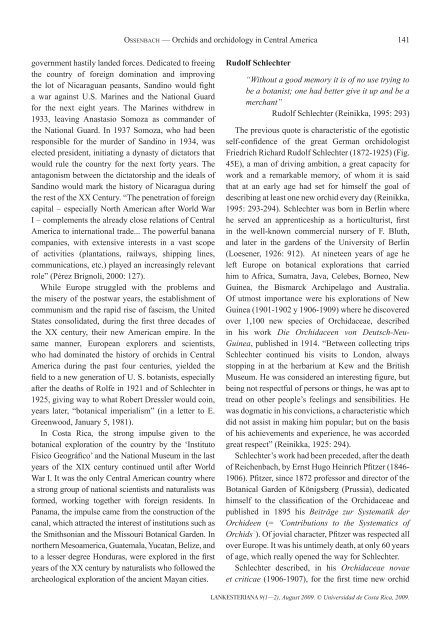orchids and orchidology in central america. 500 ... - lankesteriana.org
orchids and orchidology in central america. 500 ... - lankesteriana.org
orchids and orchidology in central america. 500 ... - lankesteriana.org
Create successful ePaper yourself
Turn your PDF publications into a flip-book with our unique Google optimized e-Paper software.
ossenbaCh — Orchids <strong>and</strong> <strong>orchidology</strong> <strong>in</strong> Central America<br />
government hastily l<strong>and</strong>ed forces. Dedicated to free<strong>in</strong>g<br />
the country of foreign dom<strong>in</strong>ation <strong>and</strong> improv<strong>in</strong>g<br />
the lot of Nicaraguan peasants, S<strong>and</strong><strong>in</strong>o would fight<br />
a war aga<strong>in</strong>st U.S. Mar<strong>in</strong>es <strong>and</strong> the National Guard<br />
for the next eight years. The Mar<strong>in</strong>es withdrew <strong>in</strong><br />
1933, leav<strong>in</strong>g Anastasio Somoza as comm<strong>and</strong>er of<br />
the National Guard. In 1937 Somoza, who had been<br />
responsible for the murder of S<strong>and</strong><strong>in</strong>o <strong>in</strong> 1934, was<br />
elected president, <strong>in</strong>itiat<strong>in</strong>g a dynasty of dictators that<br />
would rule the country for the next forty years. The<br />
antagonism between the dictatorship <strong>and</strong> the ideals of<br />
S<strong>and</strong><strong>in</strong>o would mark the history of Nicaragua dur<strong>in</strong>g<br />
the rest of the XX Century. “The penetration of foreign<br />
capital – especially North American after World War<br />
I – complements the already close relations of Central<br />
America to <strong>in</strong>ternational trade... The powerful banana<br />
companies, with extensive <strong>in</strong>terests <strong>in</strong> a vast scope<br />
of activities (plantations, railways, shipp<strong>in</strong>g l<strong>in</strong>es,<br />
communications, etc.) played an <strong>in</strong>creas<strong>in</strong>gly relevant<br />
role” (Pérez Brignoli, 2000: 127).<br />
While Europe struggled with the problems <strong>and</strong><br />
the misery of the postwar years, the establishment of<br />
communism <strong>and</strong> the rapid rise of fascism, the United<br />
States consolidated, dur<strong>in</strong>g the first three decades of<br />
the XX century, their new American empire. In the<br />
same manner, European explorers <strong>and</strong> scientists,<br />
who had dom<strong>in</strong>ated the history of <strong>orchids</strong> <strong>in</strong> Central<br />
America dur<strong>in</strong>g the past four centuries, yielded the<br />
field to a new generation of U. S. botanists, especially<br />
after the deaths of Rolfe <strong>in</strong> 1921 <strong>and</strong> of Schlechter <strong>in</strong><br />
1925, giv<strong>in</strong>g way to what Robert Dressler would co<strong>in</strong>,<br />
years later, “botanical imperialism” (<strong>in</strong> a letter to E.<br />
Greenwood, January 5, 1981).<br />
In Costa Rica, the strong impulse given to the<br />
botanical exploration of the country by the ‘Instituto<br />
Físico Geográfico’ <strong>and</strong> the National Museum <strong>in</strong> the last<br />
years of the XIX century cont<strong>in</strong>ued until after World<br />
War I. It was the only Central American country where<br />
a strong group of national scientists <strong>and</strong> naturalists was<br />
formed, work<strong>in</strong>g together with foreign residents. In<br />
Panama, the impulse came from the construction of the<br />
canal, which attracted the <strong>in</strong>terest of <strong>in</strong>stitutions such as<br />
the Smithsonian <strong>and</strong> the Missouri Botanical Garden. In<br />
northern Meso<strong>america</strong>, Guatemala, Yucatan, Belize, <strong>and</strong><br />
to a lesser degree Honduras, were explored <strong>in</strong> the first<br />
years of the XX century by naturalists who followed the<br />
archeological exploration of the ancient Mayan cities.<br />
Rudolf Schlechter<br />
141<br />
“Without a good memory it is of no use try<strong>in</strong>g to<br />
be a botanist; one had better give it up <strong>and</strong> be a<br />
merchant”<br />
Rudolf Schlechter (Re<strong>in</strong>ikka, 1995: 293)<br />
The previous quote is characteristic of the egotistic<br />
self-confidence of the great German orchidologist<br />
Friedrich Richard Rudolf Schlechter (1872-1925) (Fig.<br />
45E), a man of driv<strong>in</strong>g ambition, a great capacity for<br />
work <strong>and</strong> a remarkable memory, of whom it is said<br />
that at an early age had set for himself the goal of<br />
describ<strong>in</strong>g at least one new orchid every day (Re<strong>in</strong>ikka,<br />
1995: 293-294). Schlechter was born <strong>in</strong> Berl<strong>in</strong> where<br />
he served an apprenticeship as a horticulturist, first<br />
<strong>in</strong> the well-known commercial nursery of F. Bluth,<br />
<strong>and</strong> later <strong>in</strong> the gardens of the University of Berl<strong>in</strong><br />
(Loesener, 1926: 912). At n<strong>in</strong>eteen years of age he<br />
left Europe on botanical explorations that carried<br />
him to Africa, Sumatra, Java, Celebes, Borneo, New<br />
Gu<strong>in</strong>ea, the Bismarck Archipelago <strong>and</strong> Australia.<br />
Of utmost importance were his explorations of New<br />
Gu<strong>in</strong>ea (1901-1902 y 1906-1909) where he discovered<br />
over 1,100 new species of Orchidaceae, described<br />
<strong>in</strong> his work Die Orchidaceen von Deutsch-Neu-<br />
Gu<strong>in</strong>ea, published <strong>in</strong> 1914. “Between collect<strong>in</strong>g trips<br />
Schlechter cont<strong>in</strong>ued his visits to London, always<br />
stopp<strong>in</strong>g <strong>in</strong> at the herbarium at Kew <strong>and</strong> the British<br />
Museum. He was considered an <strong>in</strong>terest<strong>in</strong>g figure, but<br />
be<strong>in</strong>g not respectful of persons or th<strong>in</strong>gs, he was apt to<br />
tread on other people’s feel<strong>in</strong>gs <strong>and</strong> sensibilities. He<br />
was dogmatic <strong>in</strong> his convictions, a characteristic which<br />
did not assist <strong>in</strong> mak<strong>in</strong>g him popular; but on the basis<br />
of his achievements <strong>and</strong> experience, he was accorded<br />
great respect” (Re<strong>in</strong>ikka, 1925: 294).<br />
Schlechter’s work had been preceded, after the death<br />
of Reichenbach, by Ernst Hugo He<strong>in</strong>rich Pfitzer (1846-<br />
1906). Pfitzer, s<strong>in</strong>ce 1872 professor <strong>and</strong> director of the<br />
Botanical Garden of Königsberg (Prussia), dedicated<br />
himself to the classification of the Orchidaceae <strong>and</strong><br />
published <strong>in</strong> 1895 his Beiträge zur Systematik der<br />
Orchideen (= ‘Contributions to the Systematics of<br />
Orchids ’ ). Of jovial character, Pfitzer was respected all<br />
over Europe. It was his untimely death, at only 60 years<br />
of age, which really opened the way for Schlechter.<br />
Schlechter described, <strong>in</strong> his Orchidaceae novae<br />
et criticae (1906-1907), for the first time new orchid<br />
LANKESTERIANA 9(1—2), August 2009. © Universidad de Costa Rica, 2009.
















